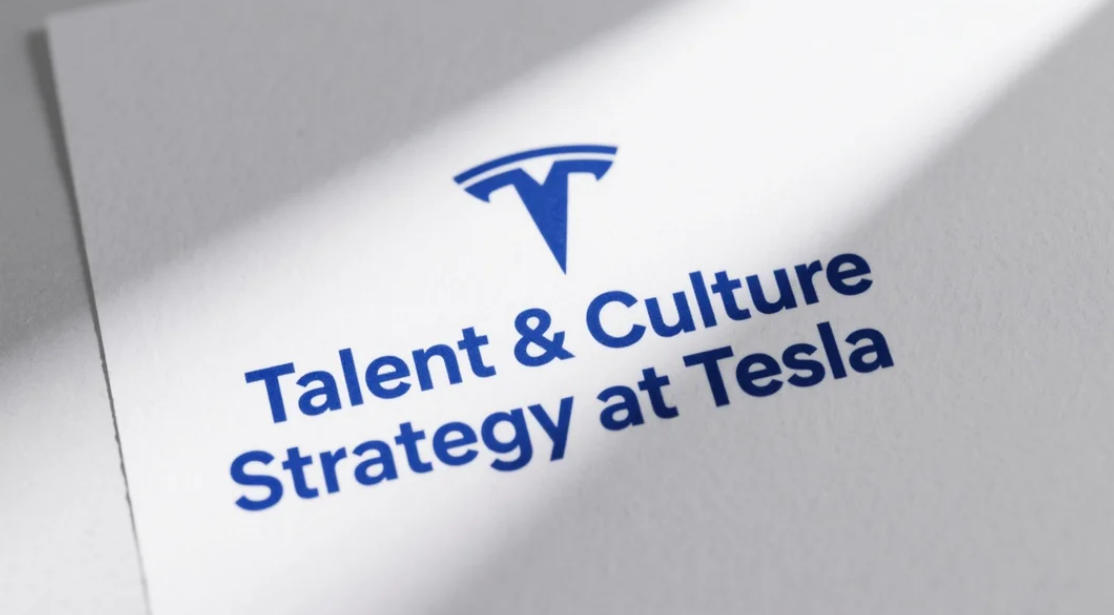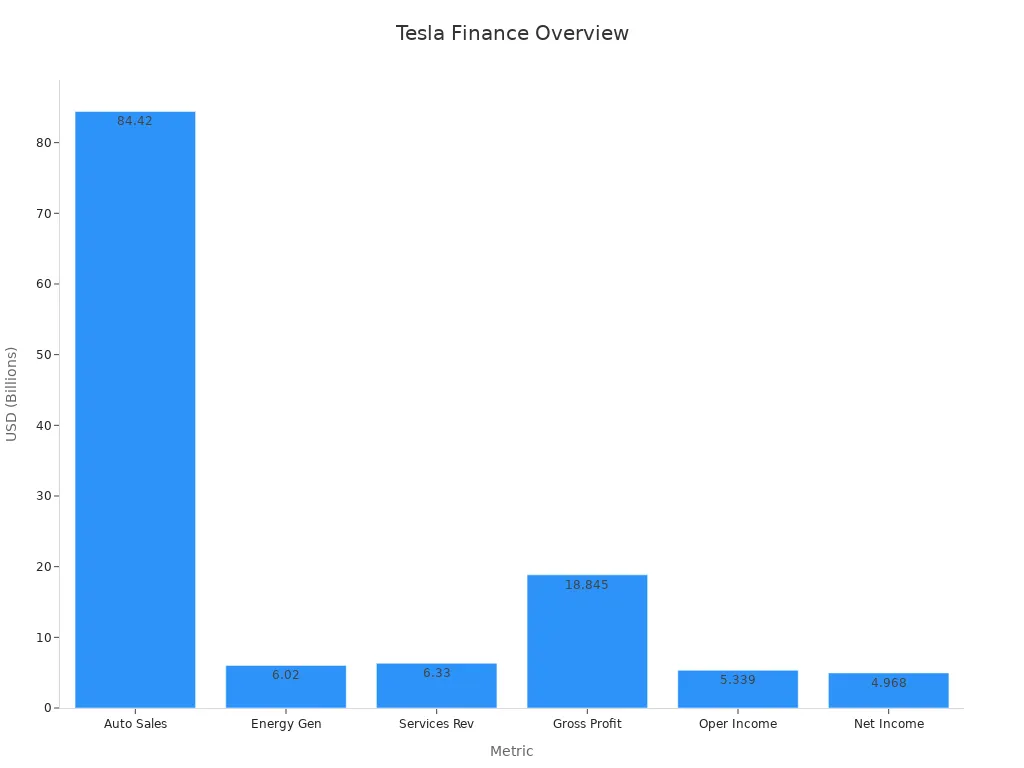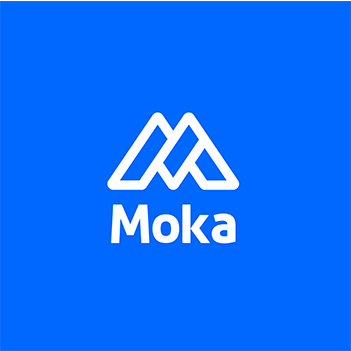Talent & Culture Strategy at Tesla

Tesla stands as a leader in both innovation and company culture. The talent & culture strategy at tesla centers on a clear vision and a culture of innovation that shapes every part of the company. Tesla’s approach includes vertical integration, automation, and a flat hierarchy, which allow fast problem-solving and strong teamwork. The company culture pushes employees to move fast, think like owners, and constantly innovate. This innovation strategy creates bold products and sets Tesla apart from competitors. A clear vision guides Tesla’s growth, helping the company manage risks and stay ahead in the market. The talent & culture strategy at tesla drives business results but also brings unique challenges.
Introduction
Overview of Tesla
Tesla stands as a global leader in electric technology and sustainable transportation. Founded in 2003, Tesla has its headquarters in Austin, Texas, and employs over 125,000 people. The company operates in the automotive industry and is publicly traded under the symbol TSLA. Tesla’s core business focuses on electric vehicles, energy generation, and storage solutions. The company’s financial strength is evident, with automotive sales revenue reaching $84.42 billion in 2024, representing 87% of total revenue. Tesla’s gross profit of $18.85 billion and a market capitalization of $1.02 trillion highlight its strong position in the market.

Tesla’s vision centers on accelerating the world’s transition to electric and sustainable energy. The company culture emphasizes innovation, transparency, and rapid problem-solving. Employees work in a flat hierarchy, which encourages open communication and fast decision-making. Tesla’s focus on technology and sustainability drives its growth and shapes its unique approach to talent & culture strategy at tesla.
HR Achievements and Recognitions
Tesla’s talent & culture strategy at tesla is built on seven core pillars: clear vision, innovation, transparency, ownership mindset, speed, continuous learning, and strong company culture. These pillars guide every aspect of human resources, from talent acquisition to employee development. Tesla’s approach to talent management stands out in several ways:
Aspect | Description | Key Points |
|---|---|---|
Tesla highlights engineers who excel in both technical and people skills. | Employees manage projects, solve complex problems, and balance big-picture thinking with attention to detail. | |
Impact of Skills on Project Outcomes | Tesla studies how skill mix affects project success. | Teams with diverse skills achieve better results and higher effectiveness. |
Employee Retention Strategies | Tesla invests in senior management and key talent. | Retention is critical to maintain productivity and avoid high replacement costs. |
Skill Development Approach | Tesla offers formal and on-the-job training, including a 3-6 month battery curriculum. | Mentorship programs and forums support continuous learning. |
Collaboration with Educational Institutions | Tesla partners with universities for internships and talent sourcing. | Early identification of skilled graduates aligns education with company needs. |
Impact of Skills on Company Performance | Management and technical skills drive company performance. | Effective skill use improves work practices and reduces employee costs. |
Tesla’s HR achievements include high rankings in talent attraction. From 2020 to 2022, Tesla ranked second among U.S. engineering students, just behind SpaceX. No other automaker appeared in the top ten, showing Tesla’s strong appeal to top talent. This success comes from the company’s innovation strategy, technology leadership, and the influence of its founder.
Company | Rank Among US Engineering Students |
|---|---|
SpaceX | 1 |
Tesla | 2 |
GM | 11 |
Toyota | 12 |
Ford | 13 |
BMW | 19 |
Tesla’s company culture also receives recognition for its focus on transparency and continuous improvement. The company’s flat structure and open communication channels help employees share ideas and solve problems quickly. Tesla’s commitment to sustainability and electric technology attracts people who want to make a difference in the world.
Conclusion: The Foundation of a Strong Workforce
The foundation of Tesla’s strong workforce comes from a structured approach based on the Organizational Effectiveness Model. This model stresses a clear business concept, strategic mission, and core strategy. Tesla builds its workforce by focusing on six key tasks: workforce acquisition, development, management systems, and a strong corporate culture. Studies show that these factors reduce growing pains and improve financial results.
Tesla’s corporate culture explains nearly half of its earnings before interest and taxes, proving the link between culture and business success.
Tesla’s talent & culture strategy at tesla sets it apart from competitors. The company’s focus on innovation, transparency, and continuous learning creates a dynamic environment where employees thrive. Tesla’s vision and commitment to sustainability drive its growth and help it lead the electric vehicle and technology industries. By building a strong foundation, Tesla ensures long-term success and maintains its position as a pioneer in electric innovation.
Defining Talent Philosophy
Tesla's core principles in talent management
Tesla builds its talent philosophy on a foundation of innovation, ownership, and alignment with its mission. The company expects employees to think boldly and act with purpose. Tesla values visionary thinking and cultural fit as much as technical skill. Employees face behavioral interview questions that test their risk-taking, resilience, and leadership. The company uses frameworks like STAR and RACE to evaluate how candidates solve problems and fit into the culture. Tesla expects employees to show strong analytical skills and make data-driven decisions. The company believes that intelligence and adaptability matter more than formal credentials. Employees learn by doing and tackle real-world challenges from day one.
Tesla’s approach ensures that every employee not only fits the culture but also drives the mission forward.
Talent Acquisition at Tesla
Tesla’s talent acquisition process focuses on finding top talent who can thrive in a fast-paced, mission-driven environment. The company uses advanced recruitment tools, including AI-powered resume screening and applicant tracking systems, to manage large numbers of applications. Candidates complete technical tests, cognitive assessments, and job simulations. Behavioral interviews help identify those who share Tesla’s values and can contribute to its goals. Data shows that engineers who rate their managers lower are more likely to leave, so Tesla launched HR programs to improve retention. The employee referral program also plays a key role. High performers tend to refer other high performers, helping Tesla attract and keep top talent. Like the collaboration with MokaHR.
Tesla’s talent acquisition uses AI-powered ATS for resume screening, technical tests, and behavioral interviews to attract mission-driven talent. Integrating a candidate-centric ATS can enhance the experience:

Job Search: AI-driven role suggestions (like LinkedIn) simplify discovery.
Application: One-click resume uploads (like Google) streamline submissions.
Transparency: Real-time status portals (like Amazon) keep candidates informed.
Feedback: Post-interview surveys (like Salesforce) improve processes.
HR Efficiency: AI prioritization (like Microsoft) speeds hiring; analytics (like IBM) boost retention.
Retention Approach at Tesla
Tesla works hard to keep employees engaged and motivated. The company encourages open communication and allows employees to bypass the hierarchy to reach leadership directly. This transparency speeds up decision-making and builds trust. Tesla’s fast-paced environment feels like a high-performance sports team, where employees must adapt quickly and take ownership of their work. Continuous learning happens on the job, not just in formal training. Tesla’s data-driven culture helps identify what keeps employees satisfied and productive. By focusing on these principles, Tesla maintains a strong, committed workforce that supports its leadership in innovation.
Talent Development and Training Programs

Why Training Matters
Training plays a vital role at Tesla. Employees must keep up with rapid changes in electric technology and innovation. The company believes that strong training programs help employees master new skills and adapt to evolving roles. Tesla invests in continuous learning to ensure that employees stay ahead in the electric vehicle industry. Training supports both personal growth and business goals. Employees who receive proper training can solve problems faster and contribute to innovation. Tesla’s focus on technology and electric systems means that employees need up-to-date knowledge at all times.
Tesla Start Program lasts 16 weeks and prepares students for electric manufacturing and automotive roles.
Annual bonuses for employees range from $3,750 to $27,500, with an average of $8,858.
Signing bonuses can reach up to $10,000 for employees with advanced degrees.
Tesla’s Approach to Employee Development
Tesla uses a structured approach to employee development. Employees participate in annual performance reviews that measure achievements over the past year. The company uses the Tesla360 Summary survey, which is based on Maslow’s Hierarchy of Needs. This survey reached a 91% participation rate, showing high engagement among employees. Top performers receive rewards such as compensation, equity awards, or promotions. Tesla links performance outcomes directly to employee growth. The company has shifted from an engagement-focused approach to a more competitive review system. Employees experience a high-performance culture that values innovation and technology. The environment encourages employees to resolve bottlenecks quickly and maintain high standards.
The Impact of Development Programs
Development programs at Tesla shape a workforce ready for the future of electric technology. Employees benefit from continuous learning and real-world experience. The company’s programs help employees adapt to new electric systems and technology. Performance management outcomes influence promotions, demotions, and firings. This creates a competitive atmosphere where employees strive for excellence. Tesla’s focus on innovation and technology attracts employees who want to make a difference. The company’s approach to employee development supports both individual success and the growth of electric technology. Employees describe the environment as both challenging and rewarding, with opportunities for advancement and recognition.
Employee Experience and Workplace Culture

What Makes Tesla’s Workplace Culture Special?
Tesla’s company culture stands out for its mission-driven workplace and relentless focus on innovation. Employees unite around the goal of accelerating sustainable energy, which gives their work deep meaning. The company culture encourages creativity and bold thinking. Leadership sets high standards and expects everyone to perform at their best. Employees feel empowered to take ownership of their projects, acting as if they own the company. This ownership mindset drives accountability and pride. The workplace thrives on teamwork, with cross-functional groups solving problems together. Continuous learning and career growth remain central to the culture. Tesla’s company culture also values inclusivity and meritocracy, especially in fields where diversity is often lacking. Employees often mention the satisfaction of contributing to global change, even as they face the challenges of a high-performance workplace.
Employees report strong job satisfaction from working on projects that impact climate change.
The company culture supports flexible work arrangements and wellness programs, helping employees manage stress.
Why Employee Engagement Matters at Tesla
Employee engagement plays a critical role in Tesla’s success. Engaged employees show higher productivity and lower turnover. A recent survey found that nearly half of US employees who left their jobs did so because they felt unappreciated. Recognition and appreciation are key drivers of employee engagement at Tesla. Employees express pride in their work, especially when developing future transportation and autopilot systems. Leadership encourages autonomy, allowing employees to leave unproductive meetings and challenge ineffective rules. Tesla’s company culture rewards initiative and innovation, which keeps employees motivated. The company offers competitive compensation, with average salaries around $110,000 per year and strong benefits. Open communication channels, such as a 24/7 integrity line, build trust and transparency in the workplace.
Evidence Aspect | Description |
|---|---|
Employee Pride | Employees value their role in shaping the future of transportation. |
Recognition Importance | Nearly 50% of resignations link to lack of appreciation. |
Autonomy | Employees can leave unproductive meetings and challenge rules. |
Compensation | Tesla pays about $30,000 more than some competitors, with strong benefits. |
Transparency | 24/7 integrity line supports open communication and trust. |
How Tesla Cares for Workers
Tesla’s company culture includes several programs to support employees’ well-being. The workplace offers flexible schedules and wellness resources to help manage the demands of a high-performance workplace. Leadership promotes transparency by allowing employees to communicate directly with management. The company culture values open feedback and quick problem-solving. Tesla’s workplace provides opportunities for continuous learning and career advancement. Employees benefit from both formal training and hands-on experience. The company culture also emphasizes safety and inclusivity, striving to create a supportive environment for all. Despite the intense pace, Tesla’s workplace remains focused on employee growth and satisfaction.
Tesla’s company culture, shaped by strong leadership and a clear mission, creates a high-performance workplace where employees feel valued and inspired.
Performance Management
Performance Evaluation and Feedback
Tesla uses a data-driven approach to performance management. The company tracks key performance indicators (KPIs) in real-time. These KPIs focus on production efficiency, quality control, and customer satisfaction. Tesla’s advanced analytics software helps managers spot problems quickly and take action. This proactive method supports a high-performing workplace and encourages innovation.
Performance Metric | Description | Operations Area |
|---|---|---|
Powertrain units produced per day | Measures productivity in powertrain production | Job Design, Supply Chain, Inventory |
Automobiles produced per day | Tracks daily vehicle output | Scheduling, Maintenance, Supply Chain |
Customer service inquiries addressed per day | Reflects customer service productivity | Human Resources, Job Design |
Tesla links these metrics to its ten strategic areas of operations management. This integration ensures that the workplace remains efficient and productive. Managers use real-time data to reduce defects and improve output. The company also uses RFID technology to speed up inventory processes and support traceability.
Feedback plays a major role in Tesla’s performance system. The company collects customer feedback through Net Promoter Score (NPS) surveys. Tesla’s NPS stands at 97, showing strong customer loyalty. Customers are grouped as promoters, passives, or detractors. This segmentation helps Tesla improve products and services. The company also analyzes thousands of customer reviews to find strengths and weaknesses.
Tesla uses quality control checks to measure battery durability and vehicle maintenance.
Time control metrics track delivery speed and cycle times.
Cost control focuses on supply chain efficiency and reducing business process costs.
Continuous improvement tools like Six Sigma and root cause analysis help refine workplace practices.
Tesla’s focus on innovation and feedback creates a dynamic workplace. Employees see how their work impacts both product quality and customer satisfaction. This approach drives ongoing improvement and supports Tesla’s leadership in the electric vehicle industry.
Tesla’s company culture stands out for its speed, innovation, and flat structure, but also brings high turnover and workplace intensity. The company culture values fast feedback, collaboration, and data-driven decisions. Other organizations can learn to empower teams, use AI for fair hiring, and promote transparency. Tesla’s company culture continues to evolve, adapting to automation and new technology. The company culture will likely shape future trends in leadership, innovation, and sustainability across industries.
Trend | Impact on Company Culture |
|---|---|
Drives efficiency and workforce changes | |
Battery Innovation | Supports sustainability and growth |
Flat Hierarchy | Fosters idea sharing and agility |
FAQ
What makes Tesla’s talent strategy unique?
Tesla focuses on innovation, ownership, and speed. The company values employees who think boldly and act quickly. Tesla’s flat structure encourages open communication. Employees solve real problems from day one. This approach sets Tesla apart from traditional automakers.
How does Tesla support employee growth?
Tesla invests in continuous learning. Employees receive hands-on training and participate in mentorship programs. The company offers formal courses and real-world projects. Tesla links performance to rewards and promotions. Employees grow by tackling new challenges every day.
Why does Tesla use a flat hierarchy?
A flat hierarchy removes unnecessary layers of management. Employees communicate directly with leaders. This structure speeds up decision-making and encourages teamwork. Tesla believes this approach helps teams innovate and solve problems faster.
How does Tesla measure employee performance?
Tesla uses real-time data and key performance indicators (KPIs). Managers track productivity, quality, and customer satisfaction. Employees receive feedback through surveys and performance reviews. Tesla rewards top performers with bonuses and promotions.
What challenges does Tesla’s culture create?
Tesla’s fast pace can lead to high stress. Employees face demanding goals and tight deadlines. Some workers report long hours. The company works to balance high expectations with support programs and wellness resources.
See Also
How To Effectively Use ATS To Discover Talent
Boost Employee Productivity Through Talent Management Tools
Transforming Hiring Processes With MokaHR’s Recruitment Innovation
Enhancing Staff Satisfaction Using MokaHR Talent Solutions
MokaHR Partners With C&T To Improve Talent Management Hong Kong
From recruiting candidates to onboarding new team members, MokaHR gives your company everything you need to be great at hiring.
Subscribe for more information

